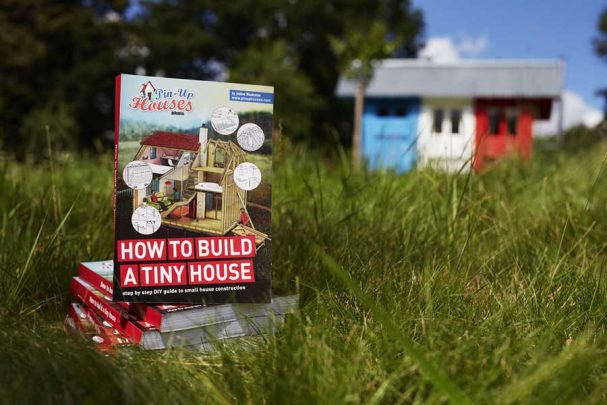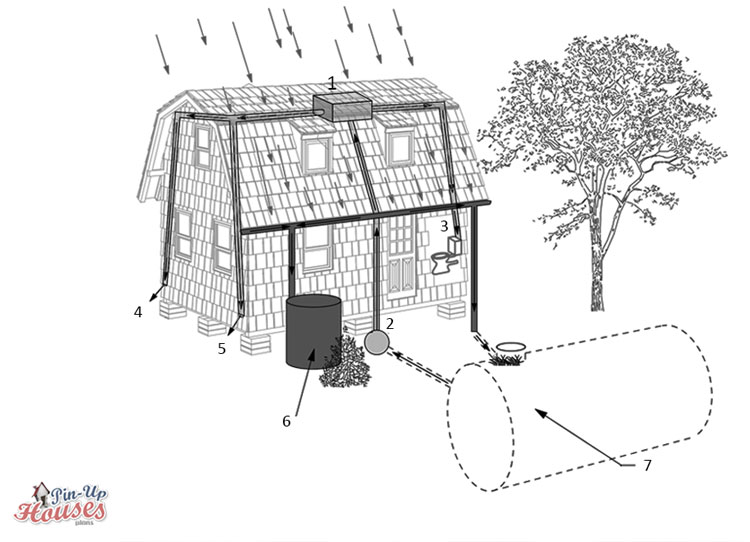
Water resources
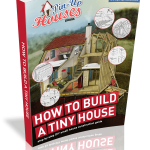
Tiny house plumbing is a big issue to solve when you’re moving into your dreamed RV, but also in other cases when you’re building a small cabin or cottage as a vacation spot, etc. We already wrote an article about heating options, and today we will concentrate on tiny house water systems, including some off-grid living solutions.
There are various options of water resources to use in your small house or wood cabin. The most common in these cases are probably the underground water sources such as connecting to the public water main or constructing water wells. These are more used in distant and non-residential areas where you can also take advantage of alternative sources of water such as rainwater, which can be filtered or cleaned with chemicals, or seawater, which you can desalinate.
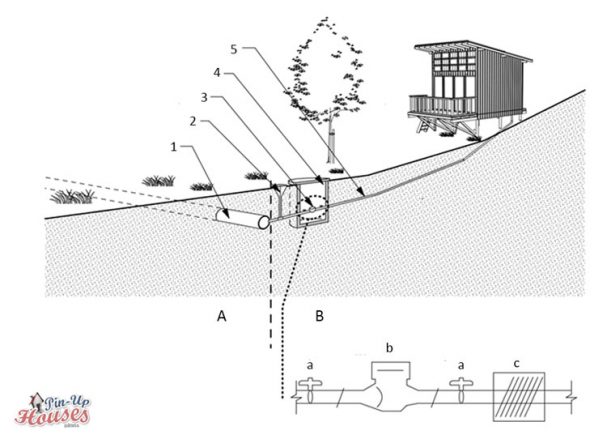
- A. Property of the water authority
- B. Property of building owner (except the water meter)
- a. Valve
- b. Water meter
- c. Filter
- Public mains
- Ground closing valve
- Water metering system
- Water meter box
- Underground water supply to the building
The biggest of natural water resources is groundwater: water, which comes from rain and soaks into the soil, filling in beds and other gaps or openings in the ground. It represents the majority of all the fresh water in the world. The easiest method to access water is, if there is an opportunity in your area, to connect to public water main, which brings water from distant reservoirs and is subject to strict hygienic rules and monitoring. But it requires a building permit, and that can become an obstacle in cases of tiny houses.
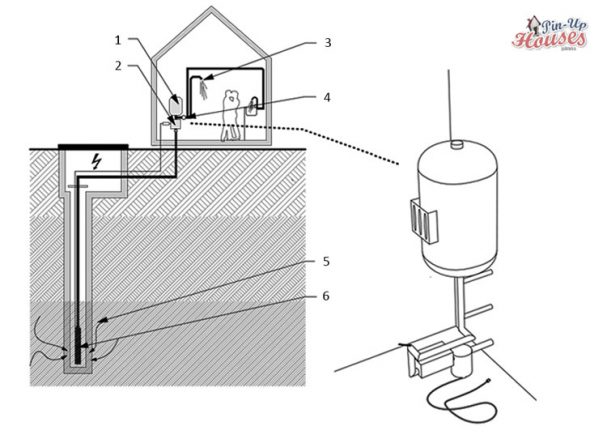
- Expansion tank
- Control unit
- Connection fittings – shower / basin / sink
- Main closing valve with drain
- Water source – underground water/tank
- Pump
Types of wells
Besides public water main, there are also off-grid water systems, most common various types of wells.
Hand-dug wells
Historically, the oldest are hand-dug wells, which are now used mostly in rural and developing countries. Their construction and maintenance are cheap and do not require any heavy machinery. It is possible to get the water even without water pumps. These wells are dug with shovels beneath the water table level, usually around 3.5 – 4 m deep (approximately 10 – 15 ft) and lined with stones, brick, wood, or in modern times mostly concrete rings to consolidate the shaft in such a way, that the lining continues higher forming a well above the ground to protect the water from contamination and people from the risk of injury. Hand-dug wells have a large diameter, bigger than, for example, drilled wells, and they can extract from shallow underground water level and less permeable materials. But they are subject to the risk of colliding with wells nearby or contamination from surrounding surface or sewage, as there is no solid steel casing. Very similar to hand-dug wells are shaft wells, except they are constructed with mining techniques and use pumps to access the water.
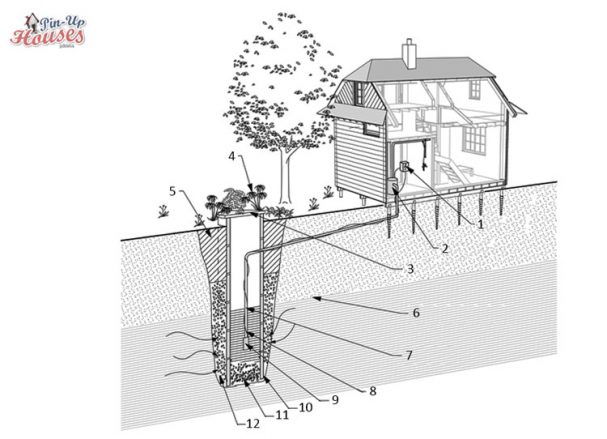
- Control unit
- Expansion tank
- Cover lid
- Landscaping hiding the good mouth
- Clay soil
- Underground water level
- Pump pipes
- Power supply for the pump
- Pump
- Concrete rigs
- Gravel
- Sand and gravel
Driven wells
Another type of wells is driven wells. Their construction is made by a small diameter pipe driven by hand or power tools into the unconsolidated ground – water-bearing sand or gravel. At the end of this pipe, a screened well point is connected to the bottom of the well to filter out sediment. Driven wells are simple and quite cheap to construct but do not have sealed casing so that they may be subject to contamination. They also extract water from shallow depths with a pump but can be deeper than hand-dug wells – up to around 9 m (30 ft) if they are dug manually and 15 m (50 ft) with a power driver.
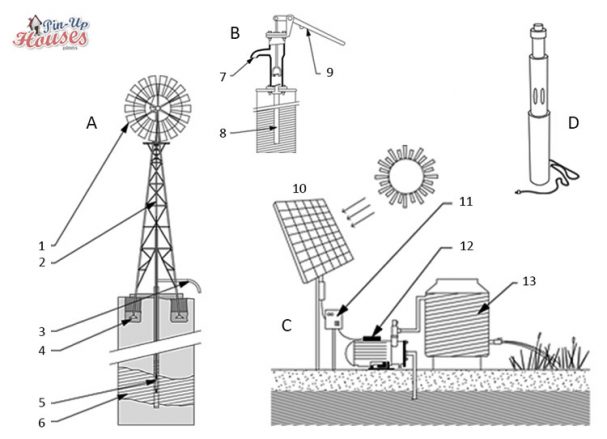
- A. Windpump, B. Manual pump, C. Solar pump, D. Electric pump
- Windwheel
- Pump rod
- Discharge
- Tower anchor
- Pump
- Aquifer
- Water outlet
- Water suction line
- Force rod
- Solar panel
- Pump control unit
- Pump
- Water tank
Drilled wells
Last to describe are drilled wells, also called boring wells, large-diameter wells drilled with augering, rotary, or cable tool drilling machines that are usually mounted on large trucks or trailers and able to drill even through solid rock. Thus drilled wells access to water from much bigger depths than hand-dug or driven wells – their usual depth is from 3 to 18 m (10 – 65 ft). However, they can go as deep as 900 m (3000 ft). To avoid collapse or contamination of the water, a casing is put around the good shaft. The casing is made of steel pipe or plastic/PVC segments, usually at least 6 m (20 ft) long, welded together and sealed around with grouting material, such as cement or bentonite clay the water is protected from contamination. Some machines are installing simultaneously during the drilling and construction process, while in other cases, it is placed after the process is finished. At the bottom of drilled wells is a screening device or filter device or an open borehole, depending on the particular formation, to let the water flow into the well.
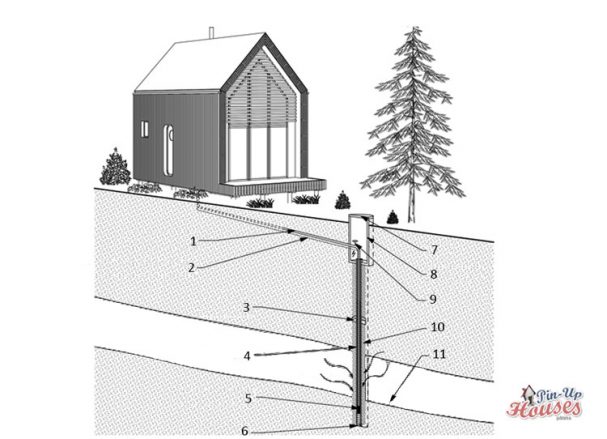
- Water connection
- Power supply cable for pump
- Concrete seal
- Perforated shoring
- Submersible pump
- Sludge catcher
- Lid
- Concrete ring
- Closing valve
- Backfill
- Underground water
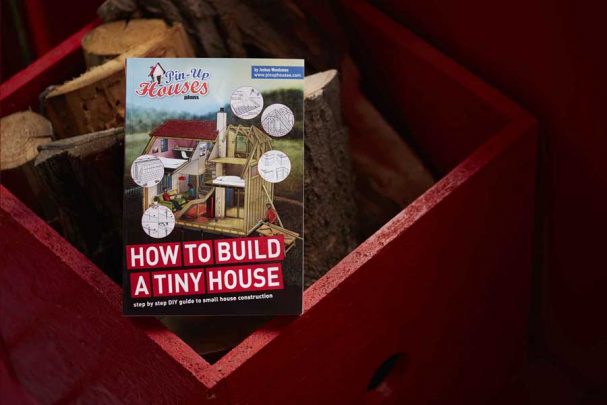
Rainwater harvesting
Rainwater harvesting is becoming a popular part of sustainable living. Rainwater is collected into tanks and stored to be reused for household activities that do not require drinking water, such as cleaning, laundry, heating, gardening, or flushing the toilet.
Rainwater collection systems
We distinguish between land-based and roof-based rainwater collection systems. Land-based rainwater harvesting means collecting water in ponds or impoundments before it is taken away by a stream or river, and this water is much more prone to contamination. Roof-based systems collect the water before it hits the ground into tanks placed on the roof and then lead it to storage water tanks. This water is much cleaner, although it must be properly treated and filtered if you wanted to use it as drinking water. In this case of rainwater collection, it would also be worth considering what types of materials to use for the roof itself and keeping in mind that a steep slope makes the system work more effectively.
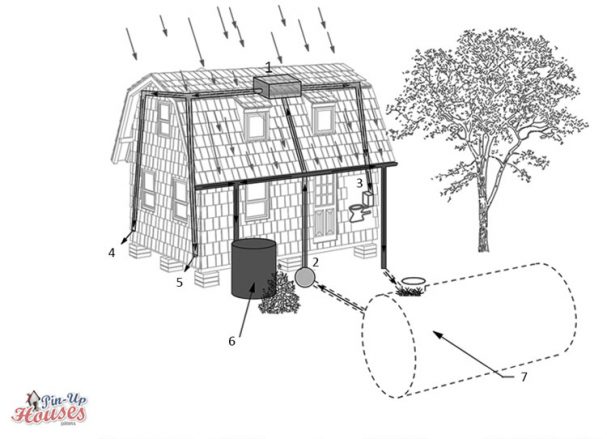
- Tank
- Pump
- WC
- Car wash
- Garden
- Overground – surface storage tank
- Underground tank
Rainwater storage tanks
A variety of systems for rain-water harvesting, from small and very easy to install to more developed, automates ones, which require a professional setup. There are two most common types regarding the storage water facilities, at least in case of the simple systems possibly suitable for your tiny houses or small cabins: freestanding and underground water tanks. Freestanding water tanks are affordable, easy to manipulate, and do not require any groundwork. But there is a risk of sensitivity towards weather conditions – they may need to be emptied during winter and can heat up and accelerate the water biodegrading during summer. Due to constant exposure to the outdoor environment, their life span is shorter, not very visually pleasing. Most of this can be prevented with the right choice of materials and insulation, but that will, on the other hand, make them more costly.
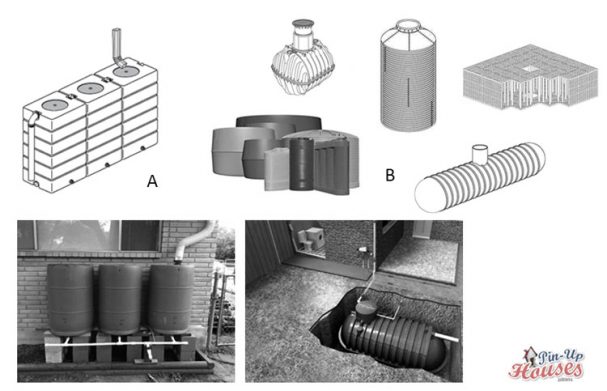
- A. Surface water storage tanks
- B. Underground water tanks
The second option for water storage is underground water tanks, which do not have weather issues and are thus more durable. They also have the advantage of being placed in the dark, which is not favorable for microbes and algae. On the other hand, they cost two to three times more than the surface water tanks. In both cases, it is important to ensure all facilities are designed to reduce potential contamination risk. Their size is large enough to capture as much rainwater as you need, especially if you considered using rainwater harvesting as your primary source of water. Although it is always advisable to have a back-up one, as weather can be unpredictable. Then all you need is a lawn sprayer, and you can water it whenever you want.
Pros and cons of rainwater harvesting
As well as other water resources, rainwater harvesting also has its pros and cons. It provides a clean, cheap, and independent water supply that can supplement the main one in case of any problems, especially in developing countries. The installation and maintenance of the simpler systems are an easy, good option. For example, areas with ground difficult to penetrate, and it helps prevent floods and bank erosions. If people use too much groundwater resources, their level decreases, so using rainwater is definitely beneficial, especially in areas with limited water sources. Collecting rainwater also lowers/minimizes one dependency on public water services. However, it can actually be incorporated into the public mains. It brings advantages of the need for a smaller amount of clean water in the distribution system and less rainwater in the sewer system.
Water heaters
Among the main decisions to make when it comes to water heating in your tiny house is to choose between storage or tankless water heater and a heating source. As experts from Local Technician point out, it is essential to do your research before deciding on which hot water system you want to have. The wrong choice can lead to costly repairs and high electric bills.
Storage water heater
Traditional storage water heater stores preheated water in an insulated tank whenever someone opens a tap or does the laundry. The tank refills automatically to have enough hot water ready and is heated either with electricity or gas burners. Storage water heater requires smaller initial costs; it is simpler and easy to install, maintain or repair. However, it cannot be placed outside; its size is bigger and life span shorter – almost half of a tankless water heater, approximately around 10-15 years. Even despite the insulation, there is always some heat lost through the tank walls creating standby losses. With heating the water automatically regardless of your actual needs, it results in a higher utility bill. Also, a given amount of water can be heated in one hour, depending on a particular type of heater, meaning you can run out of hot water and be forced to wait if your needs exceed them.
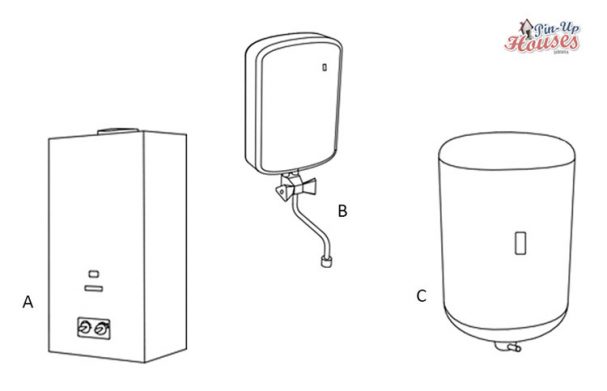
- A. Gas tankless heater
- B. Electric tankless heater
- C. electric storage heater
Tankless water heaters
A tankless heater is also called an on-demand water heater because it heats the water on demand rather than storing it. So when you turn on the tap, cold water runs through a pipe into the tank, where it is heated. This means you cannot run out of hot water, and there are no stand-by energy losses, which makes tankless water heaters more energy-efficient and cost-efficient in the long run. However, there is the limited flow of the water, and multiple uses, such as taking a shower while the dishwasher is on, maybe a problem. Although gas water heaters provide a bigger flow than electric ones, the most reliable solution would be to have more tankless heaters connected in parallel or installed directly at the point of use. It also takes up less space; some can be placed outside as well and lasts longer – approximately 20 years or more. On the other hand, installation or repair is more complicated and expensive, especially if you want to change from a traditional storage water heater. This is due to the complex system consisting of additional components, including upgraded piping and valves to regulate water flow efficiently. That also means tankless heaters require more maintenance and pose a higher risk of malfunctions, especially in extreme weather conditions, making it essential to use high-quality valves from a reliable supplier and other durable components for long-term reliability.
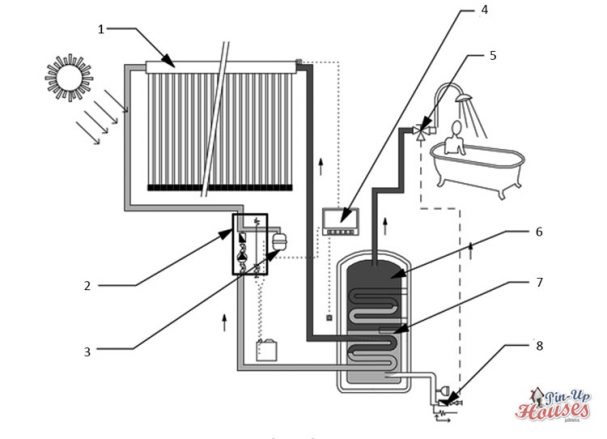
- Thermal solar collector
- Pump unit
- Expansion tank
- System regulator
- Thermostatic mixing valve
- Hot water storage tank
- Additional electric heating (cartridge)
- Water intake
Water heating fuel
Regarding the source of fuel for your water heating, there are two main options. Electric heaters are smaller, cheaper, and easier to install, but the cost of electricity consummated for your water heating will be quite big. Gas heaters, usually propane heaters, take up more space and are more complicated to install, but the running costs are lower, and they also comply with off-grid living. That brings us to an entirely alternative source of energy that can, of course, be used for your water heating as well, solar thermal connectors. The important thing is their location. You need to find a space most exposed to the sun, where you can easily access the, easily to be able to keep them clean to be the most efficient. Some sources also recommend keeping them in cooler space, such as the ground rather than the roof, because that is another way to raise their efficiency. Figuring out the panels’ size is also important, but during the summer, they may be able to supply your entire hot water consumption.
Step by step guide on timber structure
Did you find this useful? Would you like to learn more about timber structures, DIY construction, and the small house building process? When do you don´t need a building permit? Well, we have a book for you! Our step-by-step guide to building a tiny house is full of manuals, illustrations, and photographs and available to order in printed version or as an electronic book here.


